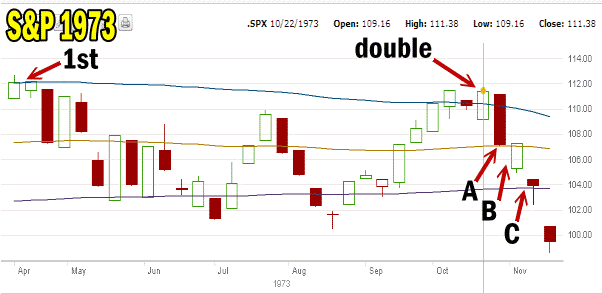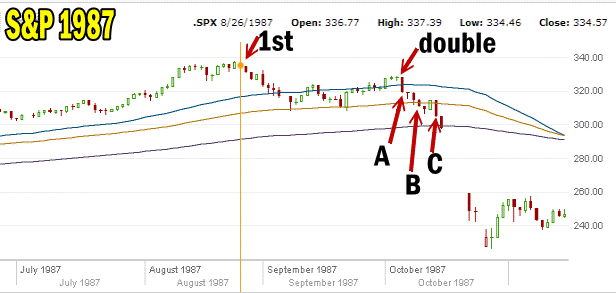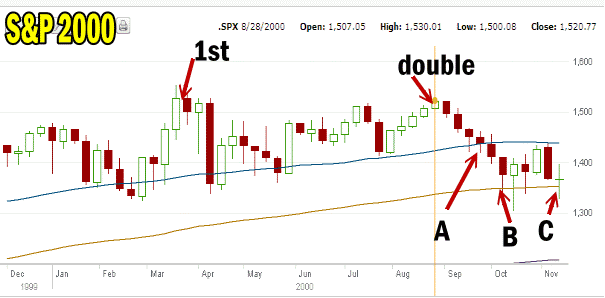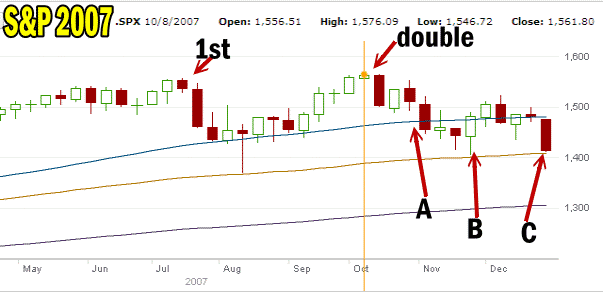Stock market direction since the market made a new 4 year high on September 14 has analysts and investors worried. The high set on September 14 has not been confirmed and the market for the past 10 days remains unable to breach the September 14 high.
The longer it takes for the markets to set a new high in market direction, the more the recent high is suspect. As investors we are always worried. Even in March 2009 as the market set new 10 years lows investors worried. Then when market direction began a recovery, we still worried. This is natural because our life’s savings are tied into risky assets. So worrying is understandable.
With us now entering October which brings back a lot of bad memories for investors, particularly those like me who have been investing for decades I thought I would share some charts that may assist in knowing when to consider a market top, no matter how short or long-term, may be in place. Through studying historic charts of other bear markets perhaps we can spot the next bear before it has the chance to shred our portfolios.
Market Direction And Spotting A Top
The media is filled with dire predictions for stocks and a plunge in market direction. But this is not new. This has been the case since I started investing back in 1972. I have never seen a year go by without scary warnings of all kinds. Everything from Dow Theory to Black Crosses to Advance Declines to well, you get the picture. Actually market crashes are not all that common. In the past 10 years it seems like they have become more common but in the big picture of the decades of the stock market, crashes are not common. Still though learning how to spot a top is obviously beneficial. Everything from 2000, to 2001, to 2008-2009, and the flash crash of 2010 warrants our being careful. But as retail investors what should we be looking at to determine if some protection should be added to our portfolios.
Look To The Market Direction Charts
To answer that question is actually easier than you may think. While nothing is ever perfect I have used the method I am describing below, for years and it has served me well. Let’s look back at a few stock charts beginning with when I was just a youngster in 1973.
S&P Market Direction Chart – 1973
In April 1973 the S&P 500 set a new all time high. The chart below is weekly as I could not find my daily chart for this period in my records. Anyway, with a top in 1973, the market pulled back and broke the 50 day simple moving average (first line), the 100 day exponential moving average (second line) and then the 200 day exponential moving average (third line). From there the market bounced, retested the 200 day and then eventually rallied back to a second high which was not as high as the 1st. This was the double top which occurred in late October 1973.
From there the market began a retreat that resulted in a vicious bear market that lasted through to October 1974. The market fell over 50% from its high. Here were the warnings signs.
A. The market direction broke through the 50 day moving average on decent volume.
B. The market direction then broke the 100 day on stronger volume. The market tried to bounce (can’t see it in the weekly chart) but failed.
C. The market direction continued lower and broke the 200 day moving average on average volume.
If you study the chart in May through to September 1973 you can see that the same events occurred. The moving averages were broken. There is never a guarantee in stocks. But when the 50 day SMA breaks it is an omen worth considering. When the 100 day EMA breaks consider protection. When the 200 day EMA breaks you should have protection in place. Even if wrong you can always remove the protection for a slight loss but just like insurance, sometimes you pay for something you may never collect on.
Think about what happened in 1973. The market made a new top in April, then spent most of the year trying to rally back only to fail in October. The collapse of stocks took a year from October 1973 to October 1974 and the market did not actually begin a strong recovery until January 1975. So a double top in the market does not necessarily mean a sudden collapse of 30% to 50% in stocks. There are early warnings. In April 1973 there were plenty of warnings. In October to November 1973 there were more warnings and still time to buy protection.
Last comment about the market direction chart, note how the strategy of selling out of positions in April and not buying back in until the late Fall would have assisted investors who by the fall of 1973 would have realized that stocks were entering a new bear market and would have stayed away secure in their profits made to April.

The market direction changed in 1973 ushering in a severe bear market for 1974
S&P Market Direction Chart – 1987
The way the media paints the market collapse of 1987 you would have thought it was a shock to everyone. This is far from true. I had shorted a number of large cap stocks in 1987 as there were only a handful of protection methods available. Shorting overbought and overvalued stocks was a good method back then. Today there are much better methods.
In 1987 the market had pushed twice in August to make two new highs. It then pulled back and fell through the 50 day simple moving average and hit the 100 day exponential moving average where it bounced. It retested the 100 day in mid December and then climbed past the 50 day. It made a double top on October 2, failed to break that top on October 5 and then pulled back through the 50 day on October 6.
Analysts announced that it was nothing and the market would regain its footing to challenge the August high. They were wrong.
A) The 50 day SMA was broken on good volume.
B) The 100 day EMA was broken and the following day the S&P 500 made a low, lower than any previous low since the August high (marked 1st)
C) The 100 day EMA was cleanly broken on larger volume and the next day the 200 day was hit. The market collapse that followed shocked investors. I was holding a number of short positions which I covered too early as I expected a strong bounce after the one day plunge. I had a number of stock broker friends who actually quit their jobs within a month of the October collapse.
The lesson here was that most investors did not look at the double top and failed to consider that the market could sell off bigger than anticipated. There was time in September to consider protection but in early October with larger volumes and the double top, no confirmation, the breaking of the 50 and then 100 day moving averages, the signs where clearly evident.

The market direction top of 1987 was readily spotted but few heeded it.
S&P Market Direction Chart – 2000
I figured in 2000 everyone suspected the stock markets would collapse as the dot com bubble was already breaking. I am using the weekly chart to show the reasons why I though the market was in big trouble. I was surprised at how many friends thought the market would recover and keep going. On March 24 2000 the S&P made a new all time intraday high of 1553.11, but there was no follow through. In April on large volume the market pulled back to the 50 day. It then spent the period from April through to September 1 trying to regain that top. Note how the S&P 500 stayed above the 50 day during most of this period. Many investors and analysts felt that it was only a matter of time before the S&P would regain the March high and continue climbing. A lot of articles during those summer months pushed stocks as being the very best opportunity as they were “under-valued” according to analysts and the summer sell-off was an event not to be missed by investors.
On September 1 a second top was made with an intraday high of 1530.11. From there the selling picked up and the S&P broke down.
A) The 50 day moving average was quickly broken and not tested as it has previously done during the summer period.
B) The 100 day held for a few trading sessions but was retested a number of times. The most telling key was that the market was not advancing but instead retesting 100 day support. It should have been advancing.
C) The market direction continued lower and the S&P 500 broke the 100 day support.
I have not included more in the chart as by this point it should have been obvious that the market was in trouble and market direction had changed to down. At the 100 day period in October and into November there was plenty of time to buy protection for what was to come.

I thought everyone was aware of the hurdle facing stock markets in 2000.
S&P Market Direction Chart – 2007
The last period I want to look at is the market direction top in 2007.
The S&P 500 market direction continued higher right into July 2007 when on July 16 it recovered to 1555.90 breaking the past high of March 24 2000. The market tried to break that high for a few more trading sessions and then sold off back to the 50 day moving average. Again the 50 day was bounced off and the market spent August and September recovering. On October 11 the S&P 500 made a new all time high of 1576.09. Analysts declared the worry of the summer as over but the new all time high was not confirmed by a continuation of the rally.
A) The 50 day was tested but did not hold.
B) The 100 day was tested and the market bounced off of it pushing back to the 50 day.
C) The 100 day was tested again and failed to hold. From there the rest is as they say, history.
Again in late 2007 with the S&P 500 below the 50 day analysts once more told investors that stocks were cheap and this was a time not to be missed. Indeed a lot of stocks did appear cheap, but in 2008 as earnings began to drop stocks became a lot cheaper. Instead that fall was a great opportunity for investors to buy some protection by using the various new bear market products that had become available to investors. Every retail investor should have made some profit from this bear market collapse. Perhaps the best non-stock market clue was when the Federal Reserve assured everyone that all the problems with the housing crisis were well contained. It seems any time government tries to reassure investors, we need to become concerned.

The great bear market collapse of 2008 to 2009 had its roots in 2007.
Market Direction And The Lessons Of History
What can we learn from the above charts?
A) There is never a guarantee that market direction is going to turn south and plunge. But there are lots of chances to buy protection when the moving averages signal that trouble could be brewing.
B) With today’s multitude of products there is little excuse for not owning protection when the market direction is signaling there are problems ahead.
C) The old strategy of using the moving averages of the 50 simple moving average, 100 and 200 exponential moving averages still holds a lot of creditability even after more than 3 decades. Therefore heed what they are signaling. Even if they are wrong, buying protection can still work out.
D) When analysts tell investors stocks are cheap by “historic” or any other measurement consider that they are not. In the end earnings win out. Earnings must support valuations and if earnings fall, stocks will at some point reflect lower earnings.
E) Stock Market Direction tops especially new highs, that are not confirmed are suspect especially when they pull back to the 50 day moving average, test it and then fall lower.
F) A climbing market needs higher highs and higher lows in order to confirm the market direction as being up. When that simple measuring stick breaks down, consider protection.
G) Not only is there time for putting on protection but warning signs often are months in advance of a severe collapse. This means protection can be applied in stages to insure adequate protection if the bear market is indeed starting and the market direction is confirmed as down.
H) Bear markets are sneaky. They often start long before investors realize they are underway.
I) Finally, no one can truly pinpoint market collapses. The Dow Theory missed most of the above bear market tops. The death crosses have been wrong so many times I often wonder why people even bother writing about them. Everything from advance-decline to insider selling has been flogged at investors as a way to judge market tops. In the end I have found that heeding the 3 longer term moving averages and watching for a rise in volume as the market breaks the 100 day exponential moving average on it way to the 200 day is as good a signal as any that investors are worried, that they are beginning to unload stocks and institutional investors are not panicked but concerned enough that they too are trimming positions to raise cash.
It may seem too simple, but sometimes when it comes to predicting market direction and the next bear market, simple may be all investors need.
